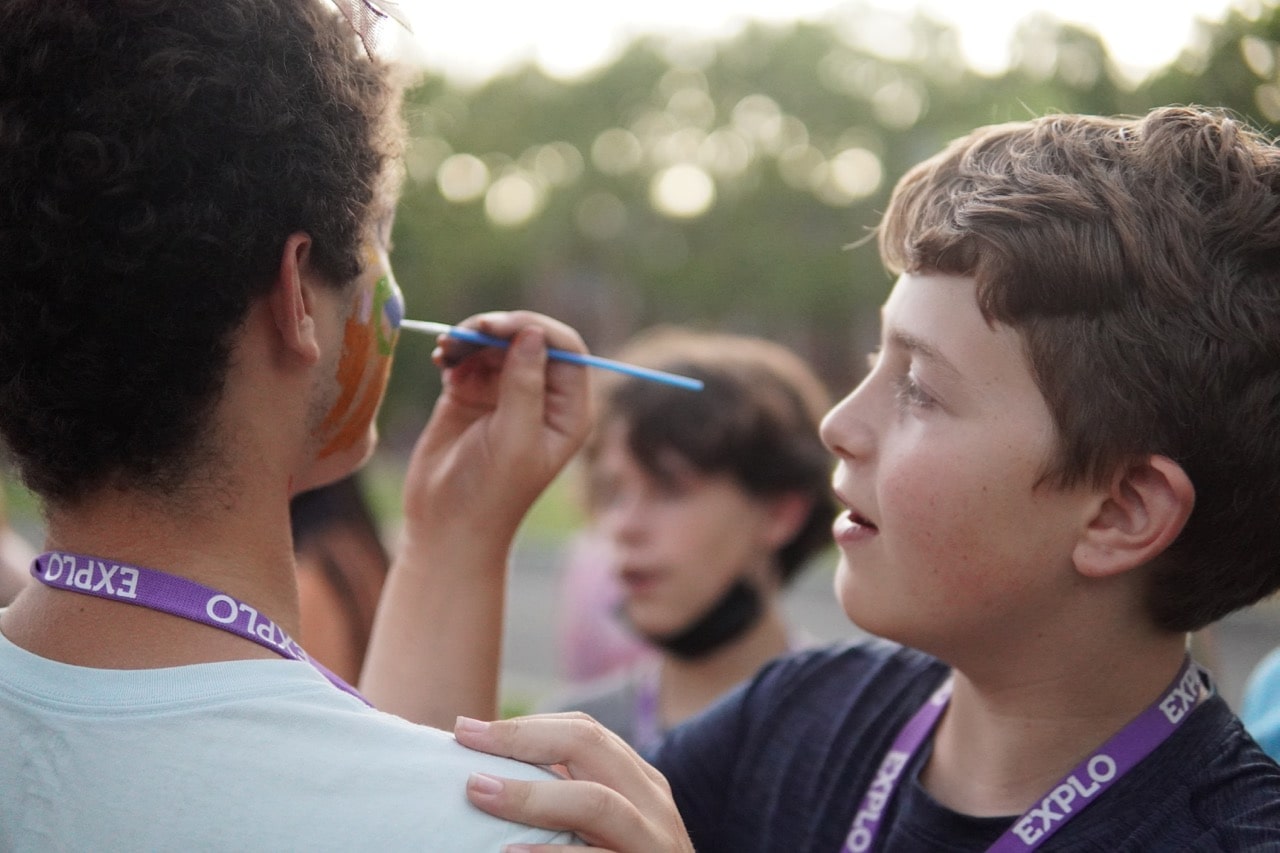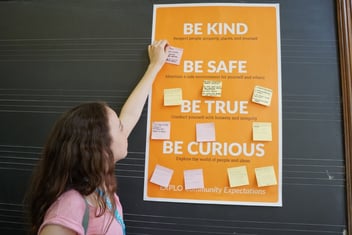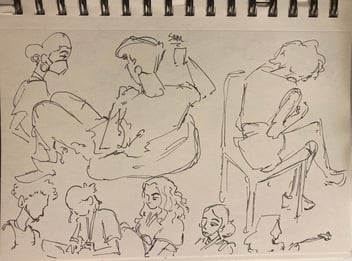How to Compare Academic Summer Programs

When you’re immersed in the field of educational summer programming every day — as we are here at EXPLO — it can be easy to forget that, to parents and children searching for their next summertime experience, the differences between summer programs aren’t all that obvious.
When you’ve narrowed down your list to a handful of academic enrichment programs — all hosted on college campuses, all boasting about their access to high-tech equipment and expert instructors, all featuring stories of happy, successful students on their websites — how do you cut your list down any further?
Here are three ways to tell educational summer programs apart. Each has to do with how a program approaches teaching and nurturing the curiosity of young minds.
1. Does the program favor an active learning or a lecture-based teaching philosophy?
As the phrase implies, active learning — also known as experiential learning — is a mode of education in which students participate in the learning process.
We’re all familiar with the traditional lecture-based teaching approach used in most university, high school, and even middle school classes. Students sit in a classroom, listen to instruction from their teachers, take notes, and are later tested on the material.
There is nothing wrong with that learning approach…but it’s only part of the story of any given subject. Decades of educational research show that students retain information better and engage more deeply with the material when they’re allowed to get hands-on with real-world applications of the subject.
A study in The Proceedings of the National Academy of Sciences (PNAS) found that “undergraduate students in classes with traditional stand-and-deliver lectures are 1.5 times more likely to fail than students in classes that use more stimulating, so-called active learning methods.”
Summer is a time for exploration, discovery, trying new things, and getting your hands dirty (figuratively and literally).
As you evaluate the educational programming of various summer programs, find out:
- Do they watch an instructor lecture and do science demonstrations for them, or are they debating and researching real-world problems and then designing experiments and labs to test their hypotheses?
- Do they simply read and discuss political and economic texts or do they build and manage their own island nations — developing trading relationships with nearby islands, putting in place environmental and health regulations, coming up with financial systems, governments, and laws for civic life?
- Do they sit at their desks, silently solving math problems, or do they compete in adrenaline-fueled, head-to-head computational challenges focused on teamwork, creative thinking, and finding math in the real world?
- Do they simply watch and discuss the structure of films, or do they take on the mantle of a filmmaker? Do they get to storyboard their narrative and then remix their scenes from their favorite films into wild new stories, editing the pieces together into their own movie trailers?
These are, of course, just a few examples of how educational summer programs might use active learning to get students enthused about subjects like engineering, science, and the arts — active learning aims to support and grow creators versus simple consumers of knowledge.
How can you be sure an academic enrichment program takes an active learning approach? Just ask. When educators believe in active learning, they’re usually more than happy to tell you all about it.
Is all active learning created equal?
While many camps use active learning methods, their approaches (and success) can vary wildly. The best camps are not just project-based: they are active, social, meaningful, and carefully architected. A curriculum designer is like an architect. A house that has been designed by a knowledgeable and experienced architect is much different than one designed by a contractor; the latter provides you with the essentials, but when you enter a well-architected home, it just looks better, feels better. Good curriculum designers have mastered the art and science of designing challenging, surprising, and substantive activities and projects — and we cannot understate the importance of the coupling of professional curriculum designers with enthusiastic instructors who promote student agency and voice.
2. What options do students have during their ‘free time?’
Over the course of any day at a summer program, there’s going to be downtime; or, at least, time that is less focused on academics. You may not think much about it, but this time off from formal learning can be just as memorable and formative to your child as their class time.
Summer programs can take vastly different approaches to fill in the non-academic portions of their daily schedules. Some simply schedule nothing. Students can hang out in their rooms, socialize, or wander around campus. Older students may even be allowed to explore the surrounding city or town on their own, unsupervised.
There’s nothing wrong with children socializing. Downtime is the perfect opportunity for participants to get to know other children from other regions and countries, representing cultures and perspectives that are different from their own. And the freedom to choose their own path and manage their time is one of the hallmarks of a transformative summer program.
But some programs are committed to not letting any time go to waste. They look at free time as an opportunity for students to socialize, unwind, and broaden their experiences, but within the framework of high-quality programming and adequate, supportive supervision.
When kids are encouraged to use their imagination and creativity during their free time, it further expands their horizons.
In this model, students may find themselves using their downtime to:
- Tinker in an open robotics studio
- Attend a performance by a local theater company
- Participate in pickup games or competitive league sports
- Practice an instrument or join a jam session
- Hang out with new friends at local cafes or restaurants (or on-campus locations for the younger student.)
- Browse a local art gallery
- Join a club or discussion group organized around an academic interest
The art behind this approach is that students are given lots of choice in which to exercise agency. Though you are not forced to go anywhere in particular, you are constantly being encouraged to participate in something. You learn to take advantage of the rich opportunities around you.
Free time, in other words, can be “free” without being unstructured.
This often leads to discovering new interests and connecting with a wide array of people. When there is very limited programming, too often students have a small peer group that they become cliquey with and they don’t expand their horizons. It’s easy for students to make a few friends on day one, and then latch on to those students for the rest of the program. But when kids are encouraged to discover and pursue new interests, they are able to build connections with other students through these mutual interests, and it further expands their horizons.
3. Does the program hit the ‘sweet spot’ with academic time?
One useful question to ask an academic summer program is: “How do you define ‘academic?’”
Some programs have a couple of hours of academics in the morning and the rest of the day is devoted to informal recreation and free time. Particularly for a residential program, that’s a lot of unstructured time.
Not that there’s anything wrong, per se, with recreation. But when your objective is to provide your child with an immersive learning environment, you don’t want a typical summer camp that sees “educational time” as just another box to check off.
On the other hand, some summer programs are all academics, all the time. The morning-to-night learning model may be a good fit for some students, but at some point, all learners need a break. A young mind benefits from the opportunity to relax, have fun, and let the day’s lessons sink in.
The best summer programs find a balance between academic and recreational time. And they provide opportunities for learning even during recreational activities, should the students choose them. For example, there may be an instructor on hand to help you build something in a maker space. A coach down at the basketball courts or soccer field to give you pointers. An instructor at the music studio to help your trio think about what to do for the talent show. Or there may be an instructor keeping an eye on the robotics lab, ready to answer questions.
Learn more ways to whittle down your list of academic summer programs
Educators and researchers are finally starting to realize what children have known for a long time: an immense amount of learning can occur in the summer when minds are allowed to roam free, experiment, and experience what the world has to offer. So choosing an academic summer camp for your child is no minor decision.
We’ve covered three ways — learning philosophy, free time, and academic time — to tell educational summer programs apart. But with literally thousands of options in the US alone, you may need more guidance. Schedule a call with one of our Admission Counselors who can answer questions about EXPLO — and connect you with one of our Program Heads or Directors of Teaching and Learning specializing in the age group of your child.
You can also sign up for a free Info Meeting! Hosted by our Program Heads, Executive Director, or Director of Student Admission + Recruitment, EXPLO info meetings give you and your family the opportunity to ask questions and get a first-hand feel for our programs. We welcome both enrolled student families and families considering applying to EXPLO to register.



